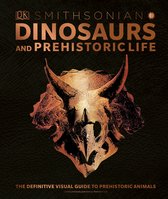Assembling the Dinosaur – Fossil Hunters, Tycoons, and the Making of a Spectacle Fossil Hunters, Tycoons, and the Making of a Spectacle
Afbeeldingen
Sla de afbeeldingen overArtikel vergelijken
- Engels
- Hardcover
- 9780674737587
- 24 juni 2019
- 336 pagina's
Samenvatting
A lively account of how dinosaurs became a symbol of American power and prosperity and gripped the popular imagination during the Gilded Age, when their fossil remains were collected and displayed in museums financed by North America’s wealthiest business tycoons.
Although dinosaur fossils were first found in England, a series of dramatic discoveries during the late 1800s turned North America into a world center for vertebrate paleontology. At the same time, the United States emerged as the world’s largest industrial economy, and creatures like Tyrannosaurus, Brontosaurus, and Triceratops became emblems of American capitalism. Large, fierce, and spectacular, American dinosaurs dominated the popular imagination, making front-page headlines and appearing in feature films.
Assembling the Dinosaur follows dinosaur fossils from the field to the museum and into the commercial culture of North America’s Gilded Age. Business tycoons like Andrew Carnegie and J. P. Morgan made common cause with vertebrate paleontologists to capitalize on the widespread appeal of dinosaurs, using them to project American exceptionalism back into prehistory. Learning from the show-stopping techniques of P. T. Barnum, museums exhibited dinosaurs to attract, entertain, and educate the public. By assembling the skeletons of dinosaurs into eye-catching displays, wealthy industrialists sought to cement their own reputations as generous benefactors of science, showing that modern capitalism could produce public goods in addition to profits. Behind the scenes, museums adopted corporate management practices to control the movement of dinosaur bones, restricting their circulation to influence their meaning and value in popular culture.
Tracing the entwined relationship of dinosaurs, capitalism, and culture during the Gilded Age, Lukas Rieppel reveals the outsized role these giant reptiles played during one of the most consequential periods in American history.
Productspecificaties
Inhoud
- Taal
- en
- Bindwijze
- Hardcover
- Oorspronkelijke releasedatum
- 24 juni 2019
- Aantal pagina's
- 336
- Illustraties
- Met illustraties
Betrokkenen
- Hoofdauteur
- Lukas Rieppel
- Tweede Auteur
- Pete Cross
- Hoofduitgeverij
- Harvard University Press
Overige kenmerken
- Extra groot lettertype
- Nee
- Product breedte
- 156 mm
- Product lengte
- 235 mm
- Studieboek
- Nee
- Verpakking breedte
- 154 mm
- Verpakking hoogte
- 30 mm
- Verpakking lengte
- 235 mm
- Verpakkingsgewicht
- 903 g
EAN
- EAN
- 9780674737587
Je vindt dit artikel in
- Categorieën
-
- Wetenschap & Natuur
- Economie & Financiën
- Geschiedenis
- Managementboeken
- Economie
- Aarde & Milieu
- Wetenschap algemeen
- Economische geschiedenis
- Aardwetenschappen
- Geschiedenis van de wetenschap
- Populair wetenschappelijk
- Rotsen, Mineralen & Fossielen
- Regio's & Landen
- Noord-, Midden-, & Zuid-Amerika
- Boeken
- Beschikbaarheid
- Leverbaar
- Taal
- Engels
- Boek, ebook of luisterboek?
- Boek
- Studieboek of algemeen
- Algemene boeken
Kies gewenste uitvoering
Prijsinformatie en bestellen
De prijs van dit product is 31 euro en 99 cent.- Prijs inclusief verzendkosten, verstuurd door bol
- Ophalen bij een bol afhaalpunt mogelijk
- 30 dagen bedenktijd en gratis retourneren
- Dag en nacht klantenservice
Rapporteer dit artikel
Je wilt melding doen van illegale inhoud over dit artikel:
- Ik wil melding doen als klant
- Ik wil melding doen als autoriteit of trusted flagger
- Ik wil melding doen als partner
- Ik wil melding doen als merkhouder
Geen klant, autoriteit, trusted flagger, merkhouder of partner? Gebruik dan onderstaande link om melding te doen.








